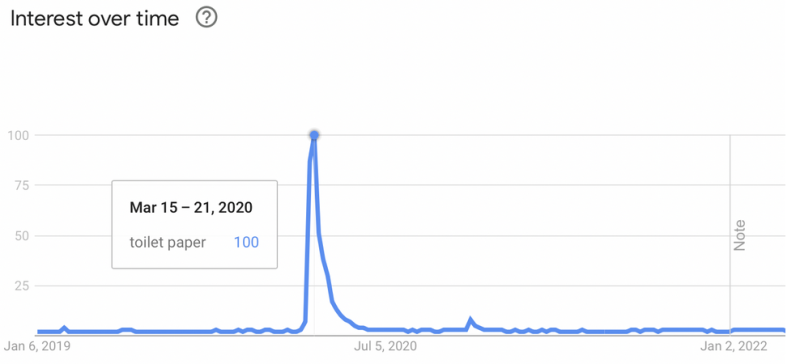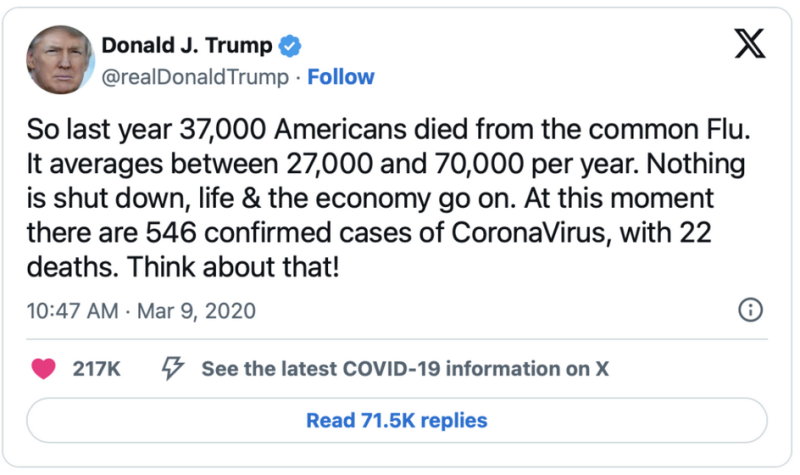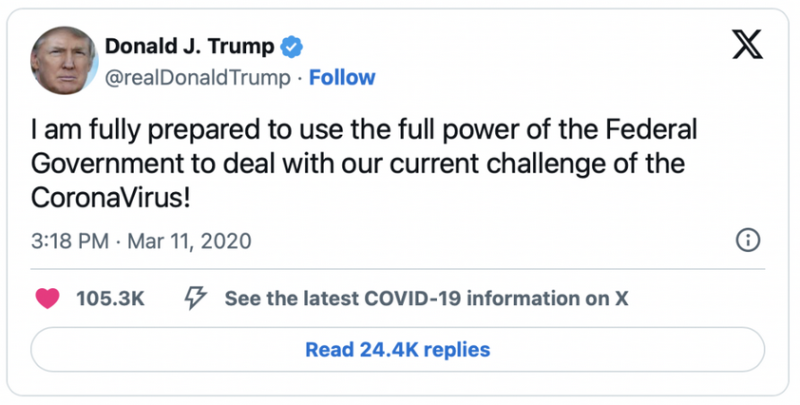
Public culture today is replete with excuses for why lockdowns had to happen. Seems like more are being generated by the day and hour.
Fauci last year started claiming that it had to happen because freezer trucks were filling up with bodies. But that doesn’t fit the timeline, as I’ve shown. The freezer trucks appeared after lockdowns because coroners stopped working, funeral homes were closed, cemeteries reduced their hours, and hospital staff were afraid to touch dead bodies.
Bodies were stuffed in trucks because there was nowhere else for them to go. This was a result, not a cause of, lockdowns.
Lately I’ve been hearing that we had to lock down because the nation was in a panic as evidenced by the famous toilet paper shortage of the Spring of 2020. It’s not clear how this is supposed to work. How does a toilet paper shortage indicate the presence of a killer disease that can be mitigated by shutting everything down?
The story of the toilet paper shortage is slightly more complicated and cannot be fully debunked by a timing mismatch. We started seeing reports of toilet paper shortages in the first week of March 2020, mostly in Australia where panic was high despite reporting zero cases or deaths. But the news stories also emanate from California, where talk of lockdown was already in the air.
The searches for toilet paper on Google peaked following lockdowns (which were codified in the US on March 16, 2020). It was during this time that people started fleeing their offices in the cities for home-bound safety. For a time in late March and continuing for another month or longer, there was a real shortage of household toilet paper. People ran out and started having to improvise. This certainly increased the level of panic and drove home a sense that something terrible was happening, even though medically significant effects of the virus itself had not yet swept the country in a meaningful way.

Oddly, the supposed shortage overall was entirely an illusion. What actually happened is that the professional class of workers skipped going to the office and instead stayed home. Manufacturers had plenty of paper. The trouble was that it was the wrong kind. It was the rolls available for offices, which are of a different shape and type, rather than rolls for domestic use. The stores faced a sudden increase in demand for one type over another. It took a while for the manufacturers to retool and match supply and demand.
“Because the paper products we use at work and home differ, and because people suddenly began working at home en masse, retail stocks of toilet paper for at-home use quickly vanished,” reported Phys.org. “Companies couldn’t quickly flood stores with more toilet paper because their processes were never designed to respond to surges in demand. Rather, they were designed to be steady, cheap and efficient to make the most of a product with a low profit margin.”
The rather quick alleviation of the seeming shortage is a tribute to the ability of markets to respond to suddenly changed conditions. On March 13, 2020, the New York Times reported that “Walmart said it was adjusting its supply routes to keep up. The company is picking up many high-demand products at factories and shipping them in trucks directly to stores, bypassing regional distribution centers.”
In other words, while it is true that the lack of availability of domestic paper created an atmosphere of brokenness, this was entirely due to the way people were consuming it, which, in turn, was a reflection of new work-at-home habits. It in no way signaled much less triggered a need to lock down. It only suggested that markets need some time to adjust to new habits.
This speaks to a social phenomenon that has been heretofore underappreciated. Did people fear the virus or fear the lockdowns? This is an interesting question. It is usually assumed that people were panicked over getting the virus. Surely there is truth in that. But my personal experience in New York City March 11-12, 2020 – a critical turning point – shows otherwise. I was on the train, in restaurants and bars, and in studios. The primary fear I saw was not of the virus – there were no masks in sight – but of some extreme response by government. The people on my train were genuinely concerned that the train would be forcibly stopped and we would all be taken to quarantine camps.
The same goes for Google geographic tracking software, which shows dramatic changes in how people were managing their commutes, restaurant reservations, and travel plans. They all show people going home to hide. From what were they hiding? The virus? Maybe in part. But they were also fearing the government’s response. Better to be home and behind locked doors than risk something crazy.
The toilet paper problem did resolve itself as manufactures and retail outlets added dramatically to the production of paper for household use. Meanwhile, many people ended up with huge stashes of toilet paper in their houses that they will be using for years to come.
In no sense was the misalignment between supply and demand for household toilet paper an indication of the need to lock down. It was a response to the fear and reality of lockdown itself, which every pronouncement from media and government at the time stoked for purposes of getting clicks. The New York Times started this racket on February 27 with its daily podcast, which irresponsibly promoted disease fear, driving hoards of the professional managerial class into fits of frenzy, none of which did a thing to mitigate disease.
This problem affected both parties. The Trump administration itself flipped from downplaying the bug on March 9 to promising a full government response on March 11.


Whatever the reason – and there are many theories – it had no justification in freezer trucks and toilet paper shortages. Nor does the Trump administration deserve credit for its response, contrary to what National Review just wrote yesterday.
“The president’s actions were often commendable,” wrote Andrew McCarthy. “The ramp-up in protective gear, ventilators, and testing capacity was impressive, and done with deference to state sovereignty. The push to develop vaccines in less than a year is nothing short of astonishing. He’ll never get the credit he deserves for it.”
No need to march through every point. You can find a plenitude of articles on Brownstone about each subject. The protective gear came almost entirely from China, restarting the very trade that Trump had tried to inhibit. Ventilators were a killer technology whereas what the sick really needed was genuine care with repurposed and known antivirals. Most of the ventilators ended up selling at a steep discount on the free market. The testing capacity was deployed mostly to further panic and certainly did not make anyone well.
As for the vaccine and how “astonishing” it is, it was the Trump administration that granted the makers immunity from damages of which there have been many. In any case, anyone with the most passing understanding of vaccines knows that you cannot use them to end a fast-moving and fast-mutating respiratory infection with an animal reservoir. The Trump administration’s efforts in this regard were an industrial subsidy made possible by the unwarranted panic generated by the response itself.
And what a mess the whole response made, far too much to be cleaned up by all the toilet paper in the world, household or commercial.
Disclaimer
Some of the posts we share are controversial and we do not necessarily agree with them in the whole extend. Sometimes we agree with the content or part of it but we do not agree with the narration or language. Nevertheless we find them somehow interesting, valuable and/or informative or we share them, because we strongly believe in freedom of speech, free press and journalism. We strongly encourage you to have a critical approach to all the content, do your own research and analysis to build your own opinion.
We would be glad to have your feedback.
Source: Brownstone Institute Read the original article here: https://brownstone.org/

